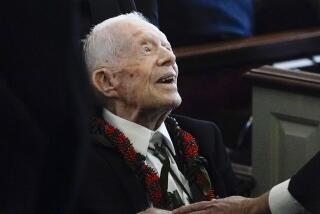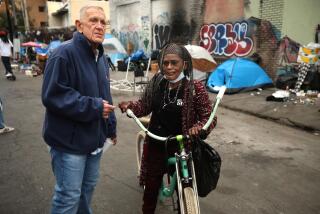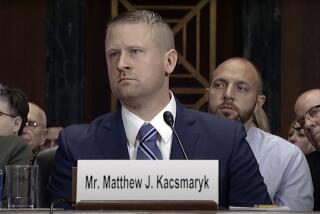Innovation Is U.S. Nomineeās Strong Suit
The first time I ever saw David O. Carter 18 years ago, he was dancing in the hallway on the second floor of the county courthouse. He was signaling to a colleague that opposing attorneys in a murder trial he was prosecuting had been doing some legal two-stepping.
I didnāt know at the time that it was Carter, prosecutor in the William Bonin serial killer case, whom my editors had sent me to interview that day.
It was a fitting introduction. I soon discovered that things are never dull around Carter, who was nominated for a federal judgeship this week by President Clinton. Itās the presidentās first federal court nomination out of Orange County.
Carter was appointed to a municipal judgeship before the Bonin case even got to trial. Heās been on the Superior Court bench the last 16 years. He did take time out once for a brief and ill-advised fling with politics, an unsuccessful run for Congress in 1986.
Carter jokes that he got the nomination this week because heās one of the few Democrats on the bench. Thatās true, but he had overwhelming bipartisan support for this nomination. Numerous leading Republicans, plus all five members of the county Board of Supervisors, wrote on his behalf.
Maybe they all figured the U.S. District Court in Los Angeles needed a little livening up.
Heās had his share of big cases. In recent months, he has angered lawyers for the brokerage firm Merrill Lynch & Co. by ordering the release of secret grand jury testimony about its role in the countyās bankruptcy.
He also presided over the guilty plea of county Treasurer-Tax Collector Robert L. Citron, who led the county into its bankruptcy debacle in 1994.
Those are standard judicial duties. Carter often goes beyond that.
In recent years, he has championed a program to help
former gang members get their gang tattoos removed, a big step in helping them find employment. Iāve also seen him have illegal immigrants deported rather than sent back to jail after a hearing.
Municipal Judge Wendy S. Lindley told me once she saw something in Carterās courtroom that changed her life. A pregnant woman facing jail on an alcohol-related charge had been ordered by Carter to go to college instead. He had brought her back to court to see how her grades were doing. Said Lindley: āI told myself, this is what I want to do with my life. I want to help people like that.ā
It was an extension of a program Carter had begun when he headed Juvenile Court. He would give some young offenders a choice: Go to jail or go to school. Skip school and itās back to jail. Now, such sentencings are routine. But when Carter was doing it in the 1980s, it was novel.
Not that Carter couldnāt make you angry. I once was seething at him. Just before closing arguments in a case, he ordered the bailiff not to let anyone leave the courtroom until the lawyersā arguments were over. This was chilling to a reporter trying to keep track of half a dozen cases in different courts at the same time.
On the other hand, his tough rules made interesting copy. In one case years ago, defense lawyers requested a continuance because they needed a little more preparation time. Weāll reconvene at midnight, Carter announced; that will give you plenty of time. Faced with a midnight session, they reluctantly agreed that they could go on without a continuance.
Carterās judicial chambers resemble a mini museum of his life. There are the family pictures--he and his wife, Mary Ellen, have six children between them, plus another youth they helped put through school.
Thereās a mounted shoe with a worn-out sole, a reminder of precinct walking in his failed congressional bid. There are pictures of Carter as a young Marine.
The most noticeable artifact in the office is his 10-speed bicycle. Carter is an ardent exercise buff.
One small plaque on the wall has special meaning for him. It was given to him by his colleagues when he left the district attorneyās office to become a judge. Deputy Dist. Atty. Rick King, who now runs the district attorneyās homicide panel, calls Carter his mentor.
āWhen I was a freshman prosecutor, he was like the varsity,ā King said. āHe took time to help me in so many ways, Iāve never forgotten.ā
It was as a prosecutor, Carter said, that he first learned what the judicial system was all about.
āIād gotten this first-degree murder conviction in a tough case, and I was damned proud of myself. The victimās father had come in from Ohio for the trial, and when it was over, he thanked me for a good job. At the door, he turned to me again, and seeing his face, it made me realize that all the convictions Iād ever get, it would never bring his son back.
āA few days later, the victimās mother called. She wanted to thank me too, but also to tell me that her husband had just taken his own life.ā
That was 20 years ago, but Carter had to choke on the words before he could relate the story again when we met Friday.
About anybody who has ever been around the courthouse could probably tell a story about Carter. But hereās one that perhaps you havenāt heard.
In 1968, Carter was a young second lieutenant, with Company C, 1st Battalion, 9th Marines, front line fighters in Vietnam. They were referred to as the āwalking deadā in books about the war because of their high casualties.
By April 6, 1968, Carterās company had already been in several days of battle, capturing hills and taking prisoners. But that day, it was deployed to assist another pinned down by enemy fire near Khe Sanh. Carter was seriously wounded, hit by mortar fire.
He led his men on an assault despite his injuries, and then was wounded again, this time by small arms fire. He refused to leave the battlefield, and helped to assist others wounded in his platoon.
I didnāt get that from Carter. It comes from Lt. Gen. H.W. Buse Jr., commanding general of the Marinesā Pacific fleet. He awarded Carter the Bronze Star.
Carter spent all of 1969 in hospitals while recovering.
āMost people donāt get a whole year to lay and think,ā he said. āThat gave me the time to know I wanted to have some direction in my life.ā
He couldnāt predict then, of course, that heād wind up where he is today: a presidential nominee to the federal bench.
*
Jerry Hicksā column appears Tuesday, Thursday and Saturday. Readers may reach Hicks by calling The Times Orange County Edition at (714) 966-7823, by fax at (714) 966-7711 or by e-mail at [email protected].
More to Read
Sign up for Essential California
The most important California stories and recommendations in your inbox every morning.
You may occasionally receive promotional content from the Los Angeles Times.










